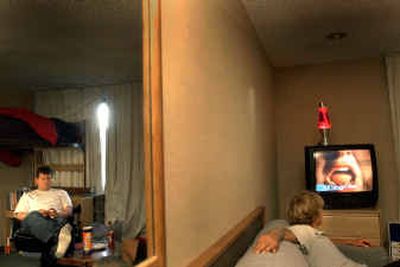GU campus bursting at the seams

Things are cooking on the parklike campus nestled on the north bank of the Spokane River.
With a record number of students, a fund-raising campaign that exceeded expectations, and a seven-year development goal that has been reached three years early, Gonzaga University is going strong, school officials say.
“Our enrollments are through the ceiling,” said Gonzaga’s president, the Rev. Robert Spitzer. “It’s an embarrassment of riches, frankly. We’re very happy.”
After enrollment problems, issues of low morale on campus and financial turmoil in the late 1990s, Gonzaga has managed to turn things around on multiple fronts. The school’s leaders credit a clear vision, an increase in demand and the generosity of the school’s alumni and friends.
Things have changed since 1998, when the school had to borrow from reserves to cover its bills. In 1999, the school’s total enrollment dropped to 4,435, the lowest for the 1990s.
Today the university’s enrollment is estimated at 6,100 with 4,140 undergraduates, setting a record. And the fund raising appears to be setting records, too.
“We’ve had an extremely successful capital campaign,” said Spitzer, adding that it’s going to good use. “Just in the last five years, we have built nine new buildings.”
The school has come very close to its $119 million goal, with a record fund-raising year of about $17 million last year, said Margot Stanfield, Gonzaga’s vice president of university relations.
The campaign, which was pulled together with the help of an outside consultant, plans to raise $48.7 million for the school’s endowment, $26.3 million of which would go to financial aid and scholarships. Though undergraduate tuition and fees are about $22,000 a year, a majority of the students receive some kind of scholarship aid through the school.
The fund-raising effort also had the goal of bringing in $57.3 million for construction and renovation on campus, the biggest chunk of which goes to a new arena and student fitness center, which cost $25 million. The rest is for projects that include a new performing arts building and residence hall renovation.
Those renovations will be needed, especially for what appears to be a record freshman class. Though school just started this week, an early assessment has the first-year students numbering a record 977. The school used its standard formula for sending out acceptances, said Registrar Jolanta Kozyra, but for some reason this year a higher ratio of students accepted Gonzaga’s offer. There also appears to be a higher retention rate for returning students, she said.
Kozyra said the school’s reputation, the increased number of students interested in college and the Northwest’s attractiveness to outsiders could have all factored into the enrollment boom this year.
Gonzaga gained national attention in 1995, when its men’s basketball team made the NCAA tournament. It has returned to the tournament six times in the years since.
The wealth of students does put some stress on a small campus, especially since the school closed down two housing buildings to make room for a department and a new 95-bed residence hall at E. 801 Boone Ave. Since fall 2001, Gonzaga has been renting space at the Red Lion River Inn to accommodate up to 80 students. This year, Gonzaga has taken on extra rooms to house about 50 students more.
The school is also planning to break ground on a new 250-bed apartment complex on Colonial Block in the spring of 2005.
In his meeting with the faculty last week, Spitzer announced the start of a new strategic plan. Momentum 2007, the plan Spitzer kicked off in 2000, was designed to grow enrollment, fund raising, marketing and quality. Besides raising money for scholarships, professorships and to further the school’s mission, the plan listed several building projects, including the expansion and renovation of the science building and the installation of high-tech classrooms.
The need for a new plan is not because the last plan had problems, said Spitzer. “We just completed that one three years early.”